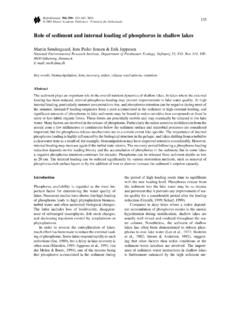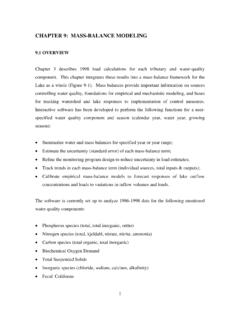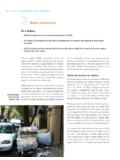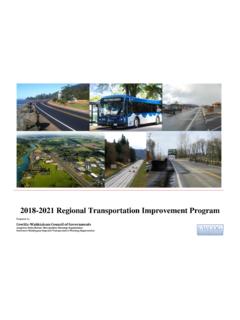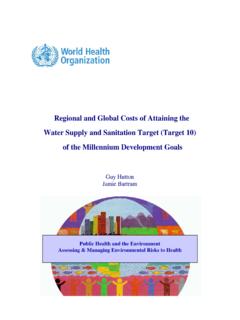Transcription of P8 URBAN CATCHMENT MODEL Program …
1 P8 URBAN CATCHMENT MODELP rogram DocumentationVersion for IEP, Bay ProjectbyWilliam W. Walker, 1990P8 URBAN CATCHMENT MODELP rogram for Predicting Polluting Particle PassageThru Pits, Puddles, & PondsA B S T R A C TP8 is a MODEL for predicting the generation and transport ofstormwater runoff pollutants in URBAN watersheds. Continuouswater-balance and mass-balance calculations are performed on auser-defined system consisting of the following elements:- WATERSHEDS (nonpoint source areas)- DEVICES (runoff storage/treatment areas, BMP's)- PARTICLE CLASSES- WATER QUALITY COMPONENTSS imulations are driven by continuous hourly rainfall and daily airtemperature time series.
2 The MODEL has been developed for use byengineers and planners in designing and evaluating runoff treatmentschemes for existing or proposed URBAN developments. The MODEL isinitially calibrated to predict runoff quality typical of that measuredunder the EPA's Nationwide URBAN Runoff Program (Athayede et al., 1983)for Rhode Island rainfall patterns. Predicted water quality componentsinclude suspended solids (five size fractions), total phosphorus, totalKjeldahl nitrogen, copper, lead, zinc, and total hydrocarbons. Primary applications include site BMP design to achieve totalsuspended solids removal efficiencies (70% or 85%) recommended by theRhode Island Department of Environmental Management (1988).
3 Simulated BMPtypes include detention ponds (wet, dry, extended), infiltration basins,swales, and buffer strips. Hydrologic components of the Program arecalibrated and tested against six years of daily streamflow data from the15,000-acre Hunt-Potowomut watershed, Rhode Island. The MODEL is used toexamine the water quality implications of alternative treatmentobjectives. Inputs are structured in terms which should be familiar to plannersand engineers involved in hydrologic evaluation. Several tabular andgraphic output formats are provided. The computer Program runs on IBM-PCcompatible microcomputers.
4 This report documents the structure,calibration, testing, potential uses, and limitations of the Program . Acompanion report (P8 URBAN CATCHMENT MODEL - User's Manual, IEP Inc.,1990) provides an overview and several example OF CONTENTSLIST OF iLIST OF Limitations of P8 and Other URBAN Runoff Intended Program MODEL Watershed and Device Particle and Water Quality Component Precipitation and Air Sample Case Entering New MODEL Simulation Design Sensitivity Flow SIMULATION Watershed Runoff Watershed Device Device Outlet Device Particle Removal Scale MODEL Particle Particle Filtration Water Quality MODEL Device Sensitivity Watershed Scale Effects of Precipitation TREATMENT MODEL A
5 - Menu Structure APPENDIX B - Data Entry ScreensAPPENDIX C - Output ScreensAPPENDIX D - Help Screen IndexAPPENDIX E - Installation & Application ProceduresLIST OF FIGURES 1P8 Main Menu 5 2P8 Device 8 3P8 Mass-Balance 9 4 Schematic Diagrams - P8 Test 5 Effect of Time of Concentration on Watershed 6 Effects of Macrophytes on Wet Pond Removal 7 Comparison of Predicted Volume Capture 8 Comparison of Predicted Volume Capture Efficiencies - Great Lakes Precipitation 9 Comparison of Predicted Suspended Solids Removal Efficienciesfor Wet Detention Suspended Solids Removal Efficiencies vs.
6 Of Predicted Phosphorus Removal Application to Hunt-Potowomut and Observed Flows - Hunt-Potowomut River - Calibration Predicted Instantaneous Peak Flow - Hunt-Potowomut and Observed Flows - Hunt-Potowomut River - Verification and Predicted Mean Daily and Predicted Monthly Total and Predicted 12-Month Moving-Average Precipitation and Runoff TSS Average Removal Efficiencies for Dissolved Species,Fine Particles, and Total Suspended Variations in TSS and Fine Particle Removal Deviations from Longterm Average TSS OF FIGURES (ct.)23 Yearly Deviations from Longterm Average TSS Relative Areas Required to Achieve 70% and 85% between Suspended Solids Removal and Violations inCopper Toxicity Criterion for Wet Ponds Treating Median Settling Velocity vs.
7 Diameter and OF TABLES 1 Mass Balance 2 Calibration of Particle 3 Calibrated Runoff 4 Water Quality 5 Input Values for Sensitivity 6 Sensitivity Analysis 7 Input Values for Hunt-Potowomut 8 Performance of Devices Designed for 70% TSS 9 Performance of Devices Designed for 85% TSS OverviewP8 is a MODEL for predicting the generation and transport ofstormwater runoff pollutants in URBAN catchments. Continuouswater-balance and mass-balance calculations are performed on auser-defined system consisting of the following elements:- WATERSHEDS (nonpoint source areas)- DEVICES (runoff storage/treatment areas, BMP's)- PARTICLE CLASSES- WATER QUALITY COMPONENTSS imulations are driven by continuous hourly rainfall and daily airtemperature time series.
8 The MODEL has been developed for use byengineers and planners in designing and evaluating runoff treatmentschemes for existing or proposed URBAN developments. This reportdocuments the structure, calibration, testing, potential uses, andlimitations of the Program . P8 is short for " Program for Predicting Polluting Particle Passagethrough Pits, Puddles & Ponds". It consists primarily of algorithmsderived from other URBAN runoff models ( , SWMM, STORM, HSPF, D3RM, TR-20). Unique features include:(1)minimal requirements for site-specific input data, typicallyavailable from drainage plans, soil surveys, and other localsources;(2)expression of input data in terms which should be familiarto local engineers and planners who normally deal withhydrologic aspects of URBAN developments.
9 (3)initial calibration of certain water-quality parameters(particle settling velocities, particle buildup/washoffparameters, particle contaminant contents) so that predictedrunoff concentrations correspond to median (50th percentile)or extreme (90th percentile) values measured under the EPA'sNationwide URBAN Runoff Program (NURP, Athayede et al.,1983); these parameters may be modified by the MODEL userswith alternative bases for calibration;(4)capability for simulating a variety of treatment devices,including swales, buffer strips, detention ponds (dry, wet,extended), flow splitters, infiltration basins (offline,online);(5)extensive user interface, including interactive operation,spreadsheet-like menus, help screens, and high-resolutioncolor Program runs on IBM-PC-compatible microcomputers.
10 Computers equippedwith 80286 processors (AT-class or higher) and numeric coprocessors Limitations of P8 and Other URBAN Runoff ModelsResults of the Nationwide URBAN Runoff Program indicate that runoffquality is highly variable from site-to-site and from storm-to-storm at agiven site (Athayede et al., 1983). The availability of calibration datalimits the accuracy and use of URBAN runoff water quality models (Huber,1986). Site-specific runoff quality data sufficient for MODEL calibrationpurposes are generally not available to the engineer/planner, particularlywhen dealing with future developments.
